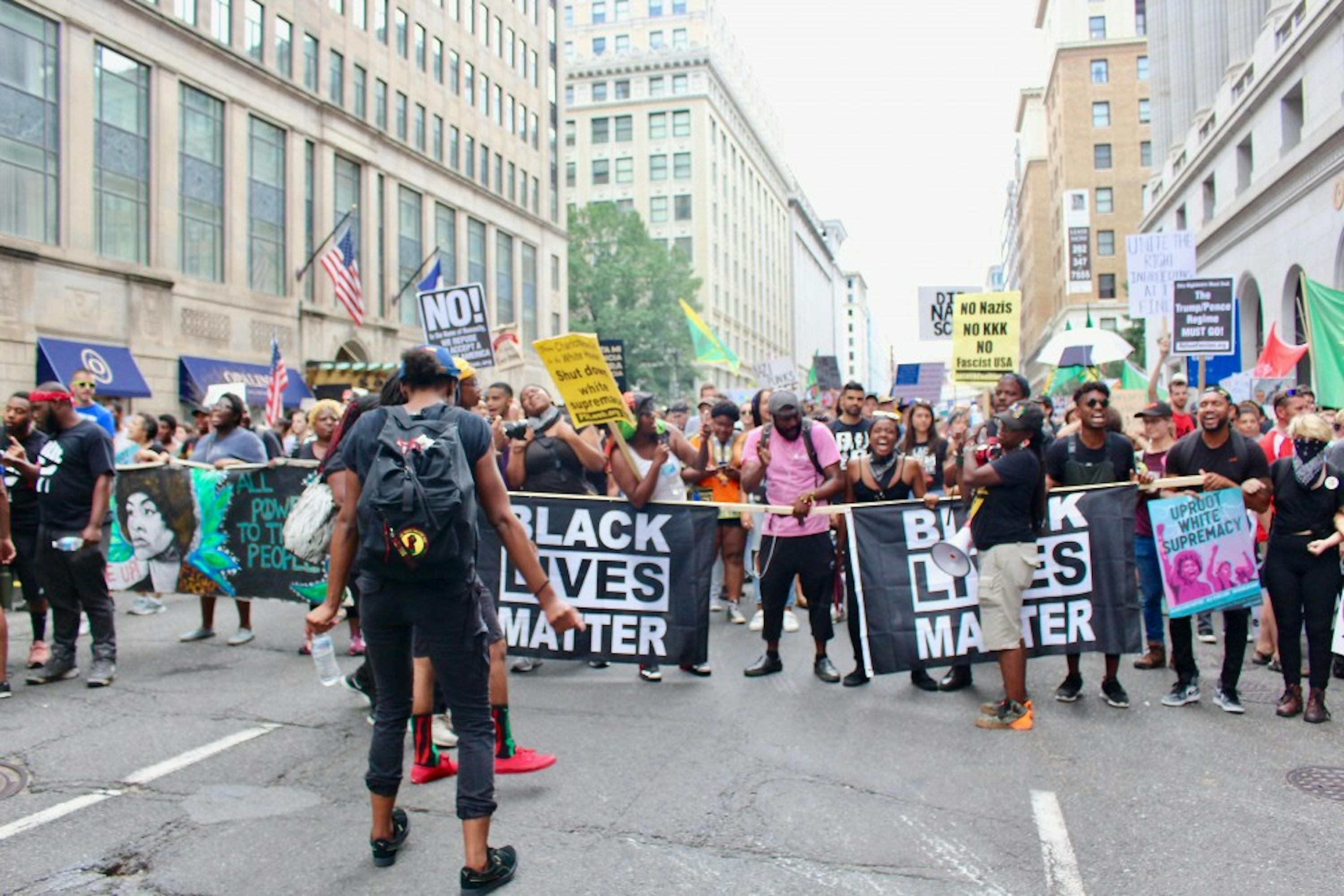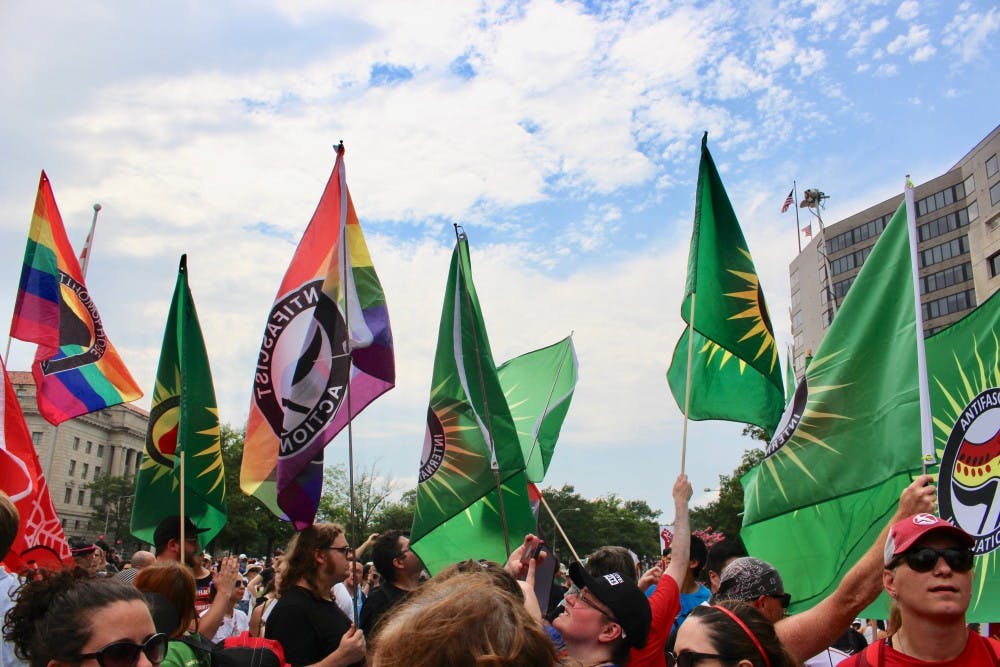Around 100 Baltimore activists traveled to Washington, D.C. to join thousands of counter-protestors at Sunday’s Unite the Right 2 rally, the follow-up to last year’s deadly white supremacist demonstration in Charlottesville, Va.
After convening in Freedom Plaza, crowds of counter-protestors marched several blocks to confront far-right members in Lafayette Square, a park opposite the White House. Though the white supremacist groups had secured a permit to demonstrate in Lafayette Square for 400 people, only about 25 arrived.
Earlier that morning, the group of Baltimore counter-protesters gathered outside Pennsylvania (Penn) Station before departing for the D.C. counter-protest. They decried the practices of white supremacists, shared personal reasons for protesting against Unite the Right 2 and aimed to demonstrate solidarity between marginalized groups.

COURTESY OF MORGAN OME
Hopkins affiliates attended the counter-protest. Peter Weck is a physics graduate student and member of Teachers and Researchers United (TRU), an advocacy group for Hopkins graduate students. He traveled to D.C. for the rally and explained that hate groups would only grow if ignored.
“We are not here today merely because we do not like the hateful beliefs of individual white nationalists,” he said. “We are here today instead to ensure that fascism is not allowed to grow as an organized political movement in this country.”
TRU hosted the event along with social justice organizations Baltimore Democratic Socialists of America (DSA), Hinenu: The Baltimore Justice Shtiebel, the Baltimore chapter of the International Socialist Organization (ISO) and Baltimore-Palestine Solidarity. Several activists spoke to a crowd in front of the Male/Female statue outside of Penn Station.
Samantha Agarwal, a sociology graduate student, ISO member and TRU representative, spoke about the rise of far-right movements across the globe and stressed the importance of focusing on celebrating diversity rather than divisions.
“We must keep not only showing up to these rallies to shut down the right, but building a renewed and vibrant left in Baltimore and across the country,” she said. “We have differences in many things, but our unity and our solidarity and our resolve to fight is what gives us strength.”
Zackary Dov Berger, an associate professor at the School of Medicine and Hinenu member, honored Heather Heyer, a counter-protester who was killed when a white nationalist drove his car into a crowd during the Charlottesville Unite the Right rally last year.
“Today is not just about defeating evil,” he said. “It’s also about remembering what Heather Heyer would have wanted, which is a new society: a society where evil is defeated but good is rejuvenated.”
Philip Clark, a member of DSA, said that organizers of the Baltimore rally sought to stand in solidarity with Baltimore residents who are against racism and white supremacy.
“It’s a really positive thing to see how many people are actually here, and I have a feeling there will be more of us here than there are of them,” he said. “Many people are actually standing up for human rights and dignity for all.”
The thousands of counter-protestors who gathered in Lafayette Square drowned out the sparse group of white supremacists with chants like “No hate, no fear, black lives matter here,” “No Trump, no KKK, no fascist USA” and “Go home, Nazis!”
D.C. Metro Police stood between the white supremacists and counter-protesters.
The rally, which was not supposed to begin until 5:30 p.m., ended at around 5:00 p.m. when the white supremacists left and police officers escorted them in vans to a nearby metro station. Soon after, counter-protestors began to disperse.
Police aimed to keep the groups separate to avoid violent clashes like those which occurred at the first Unite the Right rally in Charlottesville. Last year, hundreds of protestors gathered in the streets of Charlottesville to advocate for what they called “white civil rights.” They engaged in violence with counter-protestors, leading the Virginia governor to declare a state of emergency.
Counter-protestors took to the streets of Charlottesville on Sunday in demonstrations which were mostly peaceful, although Virginia State Police made four arrests. There was no apparent white supremacist gathering in the city.

COURTESY OF MORGAN OME
Ahead of Sunday’s demonstrations, some had worried that right-wing protesters and counter-protesters would violently face off, especially after a far-right demonstration in Portland, Ore. on August 4 turned violent. Several were left injured after police used flash bangs and tear gas to disperse the crowds at the permitless event in Portland.
In light of this, many counter-protesters who attended Unite the Right 2 were determined to avoid clashing with police or with white nationalists. Michael Rosenblum, a member of the Baltimore City and County chapter of Our Revolution Maryland, a progressive political advocacy group, explained why it was important for the protests to be nonviolent.
“That’s what gives legitimacy to our cause. That’s one thing that distinguishes us from the people that we’re protesting against,” Rosenblum said. “It gives us the moral high ground. It shows that they’re the ones who are afraid.”
For Ryan Harvey, a Baltimore resident who traveled to D.C., peaceful protesting is only one way to advocate for change. He said that working to dismantle systems of oppression is equally important.
“We’ve got to fight racism at home,” he said. “The worst forms of racism aren’t the alt-right guys with the dumb swastika tattoos on their arms; it’s the structural racism that we see in a city like Baltimore, and that’s a lot harder to challenge.”
Hopkins graduate student Peter Weck added that while he feels it is important to be present at counter-protests, there are other ways for people to get involved if they were not comfortable attending.
“This is part of a much larger movement against white supremacy and against right-wing extremism,” he said. “One of the ways that people can play a part in that, whether or not they came out today, is to get involved with struggles against racism at home, whether it’s on campus at Hopkins or around the city of Baltimore.”





